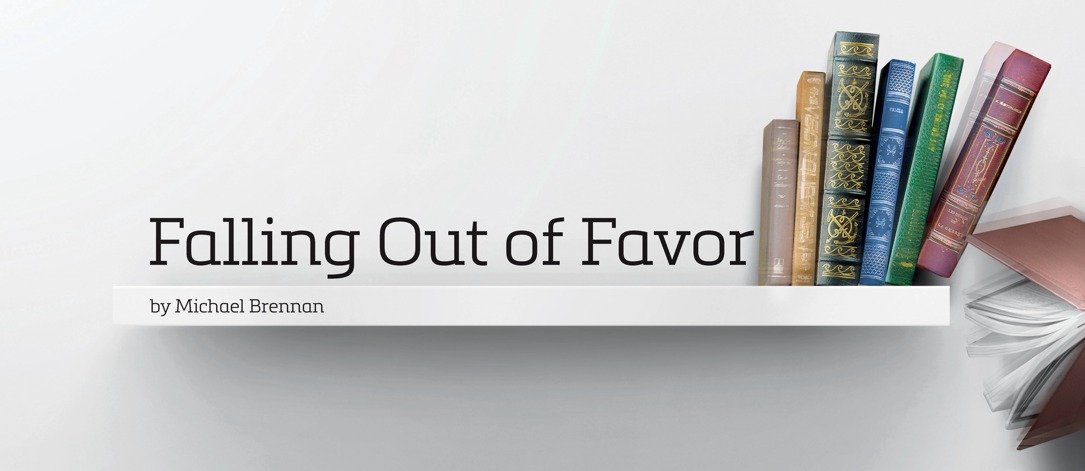You are a minority in America. Not because of the color of your skin, your religion, or your political party. Not because of your income bracket, your occupation or your opinion on hot-button issues.
Research shows that people who read have a far greater ability to communicate, to understand other people’s emotions and share their own feelings. They have a greater capacity for empathy, for feeling compassion and acting on it.
You’re a minority because right now … you are reading.
Please, continue.
While statistics vary, virtually all studies indicate that reading in this country is on the decline. The sharpest fall is among young people and students, but across all age and economic groups, the number of people who read for enjoyment, or as a primary source of information, is dwindling.
Some say the trend reflects a blighted culture, others call it enlightened—a canny, technology-driven evolution of the way people gather information and learn. Either way, it’s a sign of the times, with no reversal in sight.
“I don’t think it’s going away,” says an executive with First 5 California, an agency created to improve young children’s health and education. “I think we’re in a messy place right now.”

“If we encounter a man of rare intellect, we should ask him what books he reads.”
—Ralph Waldo Emerson
Just over half of us are readers.
According to a 2012 study by the National Endowment for the Arts (NEA), reading for entertainment is on the decline. While the percentage of Americans who read any book not required for work or school has remained relatively stable, the number of Americans who read fiction fell to 44 percent, down from 50 percent just four years ago.
While teen phenoms like Hunger Games and Twilight suggest a burgeoning generation of pleasure-readers, there is a much larger market of young adult fiction—more than 30,000 titles a year—put to the shelves.
Some publishers, perhaps in an act of self-preservation, assert that reading is as popular as ever. But numerous studies, and simple observation indicate otherwise.
Let’s look at who’s reading, and who’s not.
Less of us, overall
A decade ago, nearly a third of Americans—29 percent—were categorized as “light” readers, reading between one and five books a year—the largest category of readers in the NEA study, titled “How A Nation Engages with Art.” That number dropped to 23 percent in 2012, with fewer than one in four Americans qualifying as even light readers. The other categories, moderate (6-11 books a year), frequent (12-49) and avid (50 or more) remained steady over the last decade, but all showing significantly lower numbers.
And according to the Pew Research Center, nearly 25 percent of Americans didn’t read any books. The Pew study found that one in four Americans had not read a single book in any format—hardcover, paperback, digital or audio—a number that’s tripled since 1978.
The NEA study differentiates between readers of all books, and of literature, which it defines as a play, poem, novel or short story. In a broad stroke—fiction, and that’s most on the decline. Fiction reading increased between 2002 and 2008, perhaps providing Americans with a literary escape following the events of September 11, 2001—but those gains have been reversed.
The body politic
According to the Los Angeles Times, almost half of all Americans don’t realize each state has two senators. More than two-thirds don’t know what the Food and Drug Administration does.
“I’m not surprised,” says U.S. Congressman Doug LaMalfa, an elected official for the last 13 years. “When I was running for California State Senate, I had people telling me they hoped I’d win so I could get rid of [U.S. Sen. Barbara] Boxer. I didn’t tell them that she’s in Washington, D.C. I usually just said thank you.”
LaMalfa feels that, while the narrow segment of politically active people has widened a little, “in the broad base, the average person a generation or two ago probably knew a little more.”
Bryan Caplan, author of The Myth of the Rational Voter: Why Democracies Choose Bad Policies, believes absence of knowledge breeds irrationality among voters, who don’t consider issues beyond how they might be personally affected. They take a position of being “informed” only by their personal bias.
“The central idea is that voters are worse than ignorant; they are, in a word, irrational,” Caplan writes, “and vote accordingly.”

Chick lit
There’s a significant gender imbalance among readers, according to the NEA study. Of the 37,000 readers surveyed, nearly 64 percent of women read books, while only 45 percent of men did. The trend traces to childhood—the differences in what boys and girls read, and how frequently they read, is evident as early as the first grade.
“Girls are knocking the boys out of the box,” says Sharon Brennan, a higher education consultant with the State University of New York system.
The gap could be partially attributed to what’s available to kids, in terms of entertainment. “There’s an awful lot of ‘chick lit’ out there,” observes the First 5 California exec. (He asked he not be named—we’ll call him Harold.) Boys, he added, used to be heavy comic book readers. He remembers himself as a child waiting for new editions to come out. “But today’s comic book is Call of Glory, it’s a video game, and you’re part of it.
“And young women don’t play those games.”
Secret of my success
Not surprisingly, the percentage of adults who read increases with level of education and income. Those who attended graduate school, for example, are nearly twice as likely to have read a book in the last year as those whose education ended with high school. Of people earning between $20,000 and $50,000 annually, less than 48 percent read a book in the last year, contrasted with nearly three-quarters of people earning $150,000+.
Retire with a book
Americans 65-74 years old are bigger readers than all other grown-ups. While just more than half of adults overall read a book in the last year, 61 percent of golden agers have. “I know why,” Brennan says. “Because they can.
“Reading is a leisurely thing to do. You have to have an hour or at least a half-hour. Most people don’t feel like they have time, they have to run from one task to another, work longer hours, both parents are working—available to the boss on weekends and evenings for calls and emails.
“Who feels like they can make time to read?”
Digital dwindle
While there is growth—with e-books accounting for 27 percent of book sales in 2013—the digital book industry is slowing down. While they once enjoyed double and triple digit annual growth, e-book sales increased less than four percent in 2013.
Juvenile e-book sales dropped more than 25 percent in sales that year, according to Digital Book World, which attributes the drop largely to the absence of a Hunger Games redux—seriously. Still, a 2013 report from PlayCollective found that 54 percent of kids who read do it digitally. In 2014 that number was up to 67 percent, compared with 25 percent of U.S. adults who read e-books.
For now, it’s a “young people thing.”

“There are many little ways to enlarge your child’s world. Love of books is the best of all.”
—Jacqueline Kennedy Onassis
From birth—and sometimes before even that—reading is part of our lives. Parents read to children long before they can understand the words or the story, introducing us to the rhythm and sound of language. Other than crying, which some might call a monologue, it is the first conversation we have.
As children get older, they read to themselves—starting with favorite books they read repeatedly—Dr. Seuss, fairy tales—and then move on to books they are assigned, or find interesting—if they see their parents read. Research shows conclusively that children who don’t read are the offspring of parents who don’t read.
According to a recent Common Sense Media study, 53 percent of 9-year-olds read every day. That number drops steeply when surveying teenagers—only 17 percent of 17-year-olds read daily. “Teens don’t read like [when they were younger],” Brennan says. “They don’t have time with all their devices all the time.”
Congressman LaMalfa agrees. “They’re texting, they can’t spell words right, they’re busy downloading the latest song,” he says.
“Teenagers are spending an unlimited amount of time on their devices, and it’s ruining creativity,” chimes in Harold. “The mind needs time to wander.”
But is this really a technology and distraction issue? Older children have always read less than younger ones. With increased homework, social obligations, sports, extracurricular activities, and even jobs, one could argue they too just don’t have the time.
Indeed there’s a contingent that pooh-poohs the idea that technology aberrates a culture of literacy and learning, asserting instead that it’s a renaissance. Reading comprehension scores of 9- and 13-year-olds have improved in recent years, lending credence to the idea that literacy actually benefits from this technology.
“This is how they learn. [Kids] may not pick up a book, but they’re still learning,” says Lori Rice, an adjunct faculty member at Kaplan University. “They’re learning more than we ever did, faster and better.”
Rice, who has taught online coursework for three different colleges, believes concerns bemoaning a decrease in reading are “based on our fear and our ignorance.”
“We have to adapt to the fact that this is how [young people today] want to learn, and that they are going to be the smartest generation,” she says. “There is research that shows not picking up a book is okay.
“This is the world we’re living in.”

“Today a reader, tomorrow a leader.”
—Margaret Fuller
In bricks-and-mortar classrooms, students are definitely reading less.
“Teachers can always tell who the readers are, based on how they spell certain words in their own papers,” says Rosanne Welch, Ph.D., a professor at CalPoly Pomona and California State University at Fullerton. “Best example: the phrase ‘for granted.’ Students who are readers,” she says, will spell that correctly, “but non-readers will render it as ‘for granite.’”
“My favorite misspelling is ‘Jesus was a profit.’ I tell them spell-check is not their friend.”

 The two largest-circulation magazines in the U.S. are AARP The Magazine and AARP Bulletin.
The two largest-circulation magazines in the U.S. are AARP The Magazine and AARP Bulletin.
 The magazine in third place, and also the fastest growing, targets the other end of the generational spectrum.
The magazine in third place, and also the fastest growing, targets the other end of the generational spectrum.
 Game Informer overtook mainstay Better Homes and Gardens to win the spot.
Game Informer overtook mainstay Better Homes and Gardens to win the spot.“If spelling counts in life,” Welch continues, “reading counts in spelling.”
What students read seems to depend on where they go to school. Private schools and prep schools, where parents pay tuition for their children’s education, still for the most part assign classics like To Kill a Mockingbird, The Merchant of Venice, The Great Gatsby, and 1984.
But some public schools seem to be content to have the kids reading anything. “I go into high schools, and the teachers are assigning them things they’ll already read anyway,” Brennan says. “They’re reading Hunger Games. They’re not telling them to read The Scarlet Letter.”
“We’re teaching so much math and science now, but where did humanities go?” asks Harold.
Goldie Blumenstyk, the author of American Higher Education in Crisis? also sees a division. “There are still plenty of really smart kids going to college. The difference is in how prepared they are,” she says.
“More than half of the students at two-year colleges, and nearly 20 percent at four-year universities, are placed in remedial reading and math classes.”
That’s not a surprise to Brennan, a former Dean of Admissions at Southern Connecticut State University. “The two biggest problems are that students arrive in high school not knowing how to write, and that they’re not reading enough.”
If and when students get to college, they’re reading and writing—expanding their horizons, if you will—less and less, says Blumenstyk.
In researching her book, Blumenstyk found a report that tested 2,300 students at the beginning, middle and end of their higher education. Close to one-third showed no improvement in what they knew.
“We have a lot of kids right out of high school that have no business in college,” agrees Brennan.
Indeed, going to college is not the same as graduating—not by a long shot. Brennan cited a recent national study that showed the graduation rate at around 52 percent. And that’s after six years. After four years, the graduation rate is just 37 percent.
Brennan served on a board to create a postsecondary education planning guide for students, which discussed the options of four-year universities, two-year colleges, trade schools, and the military. She also wanted to include going into the family business, or taking a year off. “A couple of the Board members got offended. But I said, well, you have to plan for everyone.”
She points out that rarely do high schools encourage students to think of not going to college—especially prep and private schools who want their graduation numbers to reflect a high percentage of college enrollments. “I don’t think that was always the case,” she says. “I went to a private prep school, and everyone didn’t have plans to go to college, because they weren’t all going to go.”
“Now, everybody’s supposed to go to college. But not everybody is prepared or mature enough to go,” Brennan continues. “So many of the kids would benefit from a year or two off.”
“It’s amazing to me to see a kid who came to us one or two years out of high school,” she says. “They’re focused. They work hard. They know what they want.”
As a former admissions dean, Brennan attributes this to the simple fact that by the time these students “came back” to school, they’d figured out a few things: what fields interested them, what major they wanted, the job they were looking to get.
In other words, they read up on the subject—of themselves.

“News is what a chap who doesn’t care much about anything wants to read.”
—Evelyn Waugh, Scoop
In discussions of reading, most people think of books, but you, right now … are reading a magazine. That puts you among a breed of readers that’s a bit more consistent.
Magazine readership has remained fairly steady, down less than two percent from 2011, according to Statista.com, which compiles statistics from 18,000 sources. And it showed a steady increase from 2004-2011, before the minor decline.
Considering the number of baby boomers, it’s little surprise that the two largest-circulation magazines in the country are AARP The Magazine, and AARP Bulletin. Each has more than three times the circulation of even the fastest-growing magazine in the industry, which (in stark contrast) is Game Informer, a monthly gamer glossy that just overtook Better Homes and Gardens for third place.
When Americans read magazines, they read magazines, not digital copies. Even David Carey, president of Hearst Magazines, who oft touts the virtues of digital reading, admitted in 2013 that only three percent of Hearst’s total subscriber base was digital.
Data from the Pew Research Center for Media indicates that when Americans read on a screen, it’s news we’re consuming. Its most recent study showed that nearly 40 percent of people regularly get their news from a mobile device, and the number jumps to more than 50 percent when other online and digital news sources are included. That number is now higher than those who count on any form of television (local, network or cable), and is far ahead of newspapers (29 percent) and radio (33 percent).
The study also found that with the proliferation of mobile and digital content, overall news consumption is up—most markedly among tablet owners 65 and older. A whopping 61 percent surveyed in that age group says that tablet use has upped their news consumption.
It seems even the older and wiser generation is turning its back on the book.

“He that loves reading has everything within his reach.“
—William Goldwin
Reading adds to knowledge, to enjoyment, to understanding. It can be a way in, or a way out. It prepares us for what lies ahead, teaches you what came before, or offers a holiday from the here and now.
“Reading is a great escape,” Brennan says. “You’re able to get a balance, and forget about your kids and your work and your house.”
To stem the tide of the decline in reading, we must start with ourselves. We must read more. Make the time. Those of us who have children must read to them, with them—and have them see us read.
“Two-thirds of kids say that their parents, or one of their parents, is their hero,” according to professor Rice.
Researchers from The New School for Social Research have proven, in a paper published in the journal Science, that people who read literary fiction have a more enhanced set of skills and thought processes that are fundamental to social relationships and functional societies.
Research also shows that people who read have a far greater ability to communicate, to understand other people’s emotions and share their own feelings. They have a greater capacity for empathy, for feeling compassion and acting on it. People who read are the kind of people you want to be, and want to be around.
Parents read to children long before they can understand the words or the story, introducing us to the rhythm and sound of language. Other than crying, which some might call a monologue, it is the first conversation we have.































